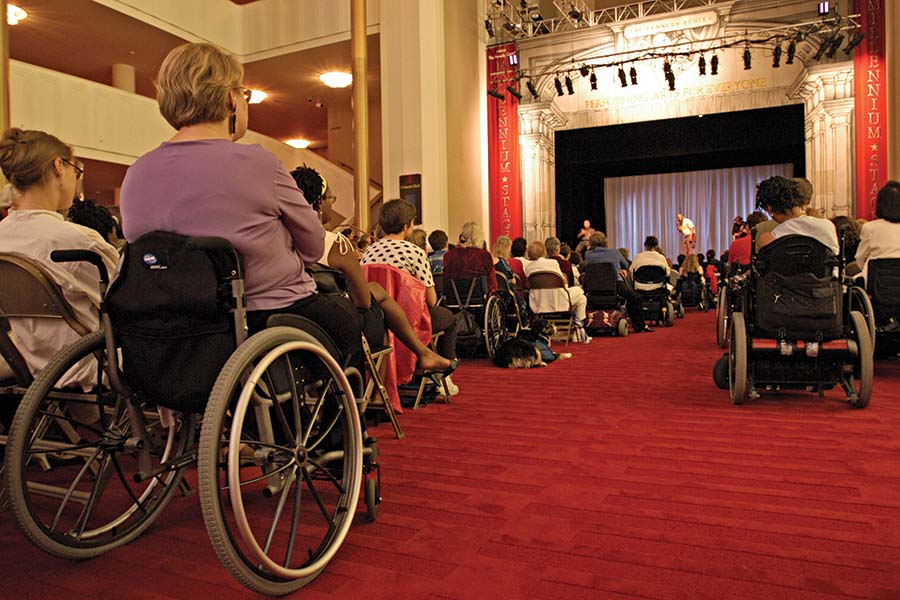“People don’t know where to begin with the topic of accessibility, so they panic—‘What do I do? Where do I start?” says Betty Siegel, director of VSA and Accessibility for the John F. Kennedy Center for the Performing Arts in D.C. To them she offers some clarifying advice: “The first thing you do, is you decide what your commitment is. In our case, the commitment we made is: We welcome people of all ages with disabilities. That’s it. From there it’s just a matter of figuring out how to honor that commitment.”
What’s your commitment to the approximately 54 million Americans, approximately one of every five, who live with a physical, emotional, intellectual, or cognitive disability? If you run a theatre, you need an approach—indeed the Americans with Disabilities Act (ADA) requires that you do. Here are some guidelines for creating a more inclusive art-making—and art-experiencing—process.
Represent. More roles should be written for and portrayed by actors with disabilities, such as those in Martyna Majok’s Cost of Living. Marilee Talkington, a performer and advocate for artists with disabilities, laments the common practice of praising able-bodied actors for tackling “this great acting challenge,” ignoring the qualified actors who don’t have to “act” disability but can act the hell out of parts if they’re given the chance.
Cast. Disabled actors can also play characters not written as disabled, and should get a shot at those too. “People with disabilities exist everywhere in everyday life,” says Jennifer Kumiyama, the first person to perform using a wheelchair on a Disney park stage. “So why don’t we exist in everyday theatre?” Casting directors, take note.
Hire. People with disabilities are also underrepresented in design, technical theatre, education, administrative, and management positions. Include them in your accessibility commitment too.
Speak. Some within the disability community use “people-first” language to emphasize that a person’s disability is just one part of who they are (i.e., “person with a disability”). However, others view their disability as an inextricable part of their identity and advocate for the use of “identity-first” language (i.e., “disabled people”). Not sure how a person wishes to be identified? Ask. Many disabled individuals compare the nuances of disability language to the ongoing national conversation surrounding gender. “I love that it’s becoming standard practice to ask for someone’s pronouns, and I think that idea can extend here as well,” says Kumiyama. “How do you wish to be identified? It can be that easy.”
Be flexible. Regan Linton, artistic director of Denver’s Phamaly Theatre Company, has one basic rule: Remain open to problem-solving. Phamaly, whose work exclusively features actors with disabilities, maintains a comprehensive document detailing all their accessibility practices, from wheelchair assistance to such details as building costumes with urine or colostomy bags in mind, or assigning dressing rooms based on each individual’s comfort with social interaction. “It’s ever-developing and ever-morphing, as we are continually discovering new ways to support our actors.”
Inform. The more information you can give to patrons and artists, the better. For people with mobility issues, it’s useful to have a heads-up about stairs, elevators, bathrooms, even accessible public transportation options near your venue. For people with an emotional disability, consider including trigger and content warnings. For people with a hearing impairment, state clearly if there are assisted-listening devices or closed-captioning systems available.
Listen. Lisa Carling, director of accessibility programs at TDF, stresses the importance of not simply implementing or revising an accessibility program because it seems like a good thing to do, but rather in response to a community need. In her nearly 30 years at TDF, Carling has seen the accessibility program grow and change in response to both community need and evolving technologies: from ASL-interpreted performances to the advent of open-captioning software, then to the emergence of autism-friendly and sensory-friendly performances. The latest: “We’re seeing a shift toward figuring out how to have access for all people, at any performance, at any time, instead of waiting for a specially designated event.”
Train. Many people, including your own house management staff, might simply not know the basics of how to interact with people with disabilities, and that can cause unintentional harm to patrons.
Reframe. “It’s not about creating a ‘carve-out’ for a ‘special’ population,” says Roger Ideishi of Temple University. “It’s about changing how you fundamentally view others. The world was created for a particular group of individuals to succeed, in a discriminatory way. From my experience, the greatest barrier is simply not seeing the wide diversity and representation of people.”





